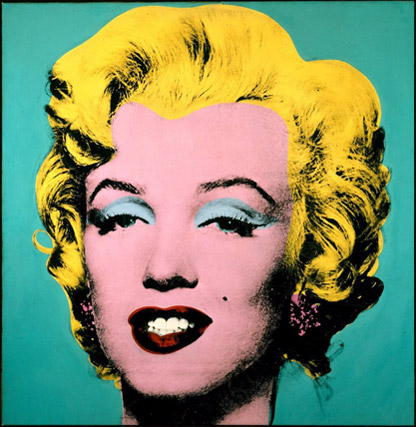The Postmodern era begins around the end of World War II, in 1945, and The Vietnam War: The Cold War, ‘55-’75. In the USA political and racial turmoil contribute to the reasons why Martin Luther King, President John F. Kennedy, and his brother Senator Robert F. Kennedy are assassinated. People learn to exchange naivety for harsh reality. Postmodern painting reflects trained artists’ responses. No longer dependent upon classical teachings, some artists begin to incorporate image-based commercial products and services. This collection of paintings illustrates the unleashing of artistic freedom.
Andy Warhol (1928 – 1959) receives free drawing classes at The Carnegie Museum of Art in Pittsburgh, PA, his hometown.
Andrej and Julia Warhola’s son’s talent is obvious from an early age. When his father dies, enough money is accumulated for tuition and Andy graduates with a degree, in Pictorial Design, from Carnegie Mellon University.
In the 1950s, Warhol’s idea of success is a job in New York City. Dreams of becoming a commercial illustrator materialize quickly and his work appears in Glamour magazine - many awards follow.
Andy’s mother leaves Pittsburg to live with her son. Their living arrangement lasts nearly twenty years. Andy respectfully credits Julia with the title of “Andy Warhol’s Mother,” for his use of her quirky handwriting, artistic flair, and the bowl of Campbell’s Soup & a sandwich she serves every day, on his lunch-break from school.

Postmodern era. (American, Pop Art movement) (1955 – 1970) blurs the boundaries between traditional fine art and commercial images.
It will be a while before art critics accept semi-mechanized, photographic images as fine art and put aside abstract expressionism.
Andy speaks out. “What’s great about this country is that America started the tradition where the richest consumers buy essentially the same things as the poorest. You can be watching TV and see Coca Cola and you know that the President drinks Coca Cola and just think - you can drink Coca Cola, too. All the Cokes are the same, and all the Cokes are good.”
It isn’t surprising that Andy transitions from a childhood fascination with movie stars’ photographs his older brother would request, in his behalf, from Hollywood Studios, to making mass-produced silk-screen images from photographs of Marilyn Monroe, Elizabeth Taylor, and numerous other celebrities, and well-known figures.
Warhol’s self-deprecating humor and perspective comes through in his art and eloquent quotes - like this one. “If you want to know all about Andy Warhol, just look at the surface of my paintings . . . There’s nothing behind them.”

Go on to Describe, Analyze, Interpret & Conclude. Contact me for help.
Campbell’s Soup Cans 1962. (Synthetic polymer paint on thirty-two canvases. Each canvas measures 20 x 16” (51 x 41 cm). Overall installation with 3" between each panel is 97 high x 163" wide
The Campbell’s Soup Company won the Gold Medallion for excellence at the 1900 Paris World Exposition and the label has been featured on its soup cans ever since. The number of paintings corresponds to the varieties of soup sold by the company. Warhol assigns a different variety to each and he checks them off on a product list Campbell’s supplies.
Irving Blum, of the Ferus Gallery, in Lost Angeles, visits Warhol. He knows Rauschenberg, and Lichtenstein, previous artists in this collection. When Blum returns to LA he offers Warhol his first one-person exhibition marking the West coast’s nod to the important new movement, in the USA.
The daring youthful art and film community are intrigued by the novelty. Blum rests the canvases on shelves and sells five before he recognizes the group functions best as a single work. Imagine him buying them back - including one from the actor/ director, Dennis Hopper. On an installment plan, Blum offers to buy the set from Warhol, for the modest sum of $3000.
Campbell’s send lawyers to investigate Warhol. Little do they realize the effect his art would have on their sales. All they could do is watch with astonishment, as Andy signs and sells the souvenirs clearing them from store shelves. This is a nostalgic image of Warhol squatting in front of a grocer’s shelf, in Manhattan.